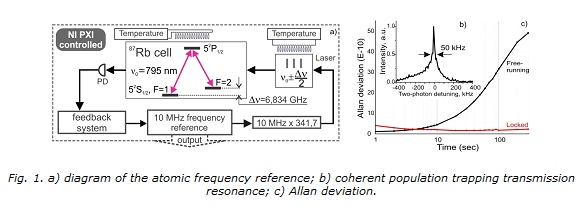Novosibirsk State University
«Poster report»
OF THE REPORT:
S.Khripunov, D.Radnatarov, S.Kobtsev, S.Turitsyn
Sergey Khripunov
Study of a laboratory prototype of an atomic frequency reference based on a coherent population trapping resonance in Rb-87.
Due to their high long-term stability, compactness, and low energy consumption, atomic frequency references based on coherent population trapping resonances (CPTR) in vapours of alkali metals are often used in many applications related to high-speed communication, precision positioning, rigorous security, and others.
One of key technologies behind CPTR frequency references relies on a laser spectrum having two frequencies with difference equal to that between levels of a hyper-fine splitting transition (for D1-line of 87Rb it is 6.835 GHz). Usually, in order to generate two frequencies with the difference required for creation of CPTR in 87Rb, injection current modulation of a single-frequency diode laser is used at the frequency of 6.835 or 3.417 GHz is used. In this case, the parameters of CPTR are highly dependent on the amplitude of high-frequency modulation and on the ratio of this amplitude to the constant component of the laser diode injection current. Experiments conducted on the set-up shown in Fig. 1, a allowed to determine optimal values of both constant and high-frequency components of the injection current, which resulted in CPTR peak contrast of 6% (Fig. 1, b) and peak width of 50 kHz. Optimisation of high-frequency modulation parameters was also key to achievement of long-term stability (over more than 300 s) of the laboratory atomic frequency reference prototype around 2.5×10–10 (Fig. 1, c). Stability of the master oscillator without frequency stabilisation over the same period was not better than 5×10–9. The present work further provides detailed description of the experimental installation and discusses prospects of improvements in long-term stability.

This work was supported by the Grants of Ministry of Education and Science of the Russian Federation (agreement No. 14.B25.31.0003, order No. 3.162.2014/K).